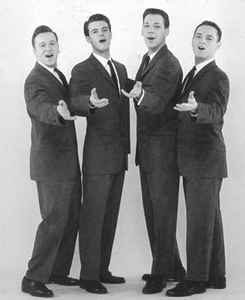Canada, a nation known for hockey, curling, poutine, and … soul? Yes indeed. I may seem to be on a mission to prove that soul music comes in all kinds of forms from all kinds of places but it only seems that way because it’s true. Sure, cities like Detroit, Philadelphia, Memphis, and New Orleans are known as soul capitols but they are hardly the only places from which soulful sounds emerged. Last week I gave you soul from London in the form of the Foundations. This week we travel north of the border to meet the Diamonds.
Their history goes all the way back to 1953 when sound engineer Dave Somerville met three like-minded guys in Toronto. The thing they had in common was that they all liked to sing and as a result, a new vocal quartet was formed. They called themselves the Diamonds and in addition to Somerville, the original lineup included Ted Kowalski, Phil Levitt, and Bill Reed. They got a positive reaction from early audiences and 18 months into their career they decided to make the drive to New York City in search of fame and fortune.
The Diamonds found what they were looking for when they tied for first place on the popular Arthur Godfrey’s Talent Scouts tv show. Their prize was a record deal with Coral Records. That, in turn, led to them acquiring manager Nat Goodman. Four songs came out of those early sessions the most memorable being a Lieber-Stoller composition called “Black Denim Trousers & Motorcycle Boots.”

The Diamonds continued to move forward and DJ Bill Randle helped them to get a deal with Mercury Records. Success came in the form of a cover of the Frankie Lymon and the Teenagers hit which reached #12 in 1955 and was followed by the #14 hit “Church Bells May Ring” that same year. The group made their first appearance on the R&B chart the following year with “Love, Love, Love” which reached #14. Bigger things were still ahead.
The real breakthrough record for the Diamonds was their take on the Maurice Williams-written “Little Darlin’.” In 1957, the single made it to #2 on the R&B chart and the same position on the pop chart. “Words of Love” and “Zip, Zip” followed “Little Darlin'” into the Top 20 and then the Diamonds scored big again with “The Stroll,” a song written by Clyde Otis which reached #4 on the pop chart and #5 on the R&B chart. Yes, 1957 was quite a year for the Diamonds.
Despite the success, by the end of the decade, three original members of the Diamonds had left the group leaving Somerville as the only original member. Replacing Kowalski, Reed, and Levitt were Mike Douglas, John Felten, and Evan Fisher. The Diamonds continued into the ’60s but by 1961 even Somerville had left. He pursued a solo career as David Troy and he was replaced by Jim Malone.
The hit-making days of the Diamonds were done but they continued as a live act, playing often in Las Vegas. Inevitably there was a battle over who owned the Diamonds name which led to two different groups of Diamonds being on the road at the same time. In one form or another, a group called the Diamonds has continued touring in the new century.





Comments